Overview
The article “10 Legacy Systems Examples You Need to Know About” serves as a crucial resource for understanding the significant impact of legacy systems across various industries. It identifies notable examples, such as the reliance on COBOL in banking, and delves into the characteristics of these outdated technologies.
Organizations face substantial challenges in modernizing these systems, which can hinder operational efficiency and security. Therefore, strategic modernization efforts are not just necessary; they are imperative.
Supported by compelling case studies, the article illustrates successful transitions that enhance efficiency and security.
Are you ready to confront the challenges of legacy systems? Embrace the opportunity for transformation and take action towards a more efficient future.
Introduction
In an era marked by rapid technological advancement, numerous organizations find themselves constrained by legacy systems that impede innovation and efficiency. These outdated platforms, often the result of substantial investments, present a multitude of challenges—from exorbitant maintenance costs to significant security vulnerabilities.
With over half of businesses still dependent on these antiquated systems, it becomes imperative to comprehend their characteristics and the reasons for their ongoing presence. This article explores the complexities of legacy systems, examining their various types, the barriers to modernization, and effective strategies for integrating them with contemporary technologies.
By showcasing successful case studies and the essential role of modern integration platforms, organizations can adeptly navigate the landscape of digital transformation and fully realize the potential of their technology investments.
Understanding Legacy Systems: Definition and Characteristics
Legacy systems, including outdated hardware and software, continue to pose significant challenges for organizations. These systems are often retained due to the substantial investments made in them and the complexities involved in transitioning to newer technologies. However, their ongoing use typically results in a lack of contemporary features, leading to inefficiencies and increased security vulnerabilities. Key characteristics of legacy systems include:
- Limited Interoperability: These systems frequently struggle to communicate with newer applications, creating silos of information that hinder operational efficiency.
- High Maintenance Costs: As technology evolves, maintaining outdated infrastructures can become increasingly expensive, requiring specialized expertise and resources that may not be readily available.
- Outdated Programming Languages: Many older frameworks rely on programming languages that are no longer widely used, complicating updates and integration with modern solutions.
In 2025, approximately 60% of organizations remain dependent on outdated technology, underscoring the ongoing challenge of modernization. Recent discussions in the sector emphasize the importance of a comprehensive approach to digital transformation, which includes strategic investments in technology and the upgrading of these legacy frameworks. Experts observe that successful enterprises strike a balance between empowering employees to innovate and adhering to structured change management processes. As noted by Gartner in 2019, ‘Successful enterprises find a balance.’ This balance allows employees the freedom to experiment with new ideas while ensuring alignment with the overall change plan.
Understanding the characteristics of legacy systems is crucial for organizations aiming to modernize their technology landscape effectively. By recognizing the limitations and risks associated with these frameworks, companies can better strategize their integration efforts and leverage platforms like Avato’s Hybrid Integration Platform. Avato is dedicated to simplifying complex connections and enhancing business value, ensuring round-the-clock availability for critical systems.
The platform provides real-time monitoring and alerts on performance, mitigating the risks tied to outdated technologies. This capability enables organizations in sectors such as banking, healthcare, and government to secure their operations for the future through seamless data integration and process alignment. Avato originated with a team of enterprise architects who recognized the need for a superior method to integrate diverse frameworks and data, reflecting the company’s strong commitment to building the technological foundation necessary for enriching, interconnected customer experiences.

Types of Legacy Systems: An Overview
Legacy frameworks can be classified into several distinct types, each possessing unique characteristics that significantly influence their relevance and functionality in today’s digital landscape:
- Mainframe Units: These large, powerful computers are designed for bulk data processing and are often utilized by industries requiring high-volume transaction processing, such as banking and healthcare. Despite their age, mainframes remain essential to many companies, with approximately 30% of enterprises still relying on them as of 2025.
- Custom-Built Applications: Specifically designed for a business, these applications often lack ongoing vendor support, making them challenging to maintain and update. As companies evolve, the inflexibility of these frameworks can stifle creativity, leaving firms at a competitive disadvantage.
- Proprietary Software: Owned by specific companies, proprietary software is not accessible for public use and can become obsolete rapidly. Entities utilizing such software may face significant challenges in integration and scalability, especially as technology continues to evolve.
- End-of-Life Systems: These technologies are no longer supported by their manufacturers, presenting considerable risks to entities. The dependence on obsolete technologies can lead to security vulnerabilities and compliance challenges, particularly in regulated sectors.
By 2025, a substantial portion of entities persists in using various outdated technologies, with mainframe solutions still holding a critical position in sectors such as finance and healthcare. Industry leaders emphasize that investing in the modernization of these structures is crucial; studies reveal that 81% of business leaders consider digital transformation vital for organizational success. This sentiment is echoed in recent discussions among C-suite leaders from hospitals and health networks, highlighting the significance of strategic collaborations in managing the complexities of outdated software connections.
Furthermore, Avato’s hybrid connection platform supports 12 levels of interface maturity, greatly assisting entities in addressing the challenges posed by legacy systems. By facilitating seamless integration and enabling significant transitions with minimal downtime, Avato empowers financial institutions to effectively modernize their operations. The shift towards cloud-native development is gaining momentum, with projections indicating that 90% of new apps will adopt cloud-native architecture by 2025.
This trend underscores the imperative for companies to embrace contemporary principles to enhance efficiency and foster innovation.
In conclusion, understanding the varieties and characteristics of outdated frameworks is crucial for organizations seeking to modernize their operations and enhance their competitive advantage in an increasingly digital environment. The lack of adaptability in traditional frameworks to scale with growth further underscores the necessity for investment in digital transformation efforts, a challenge that Avato is well-equipped to address.
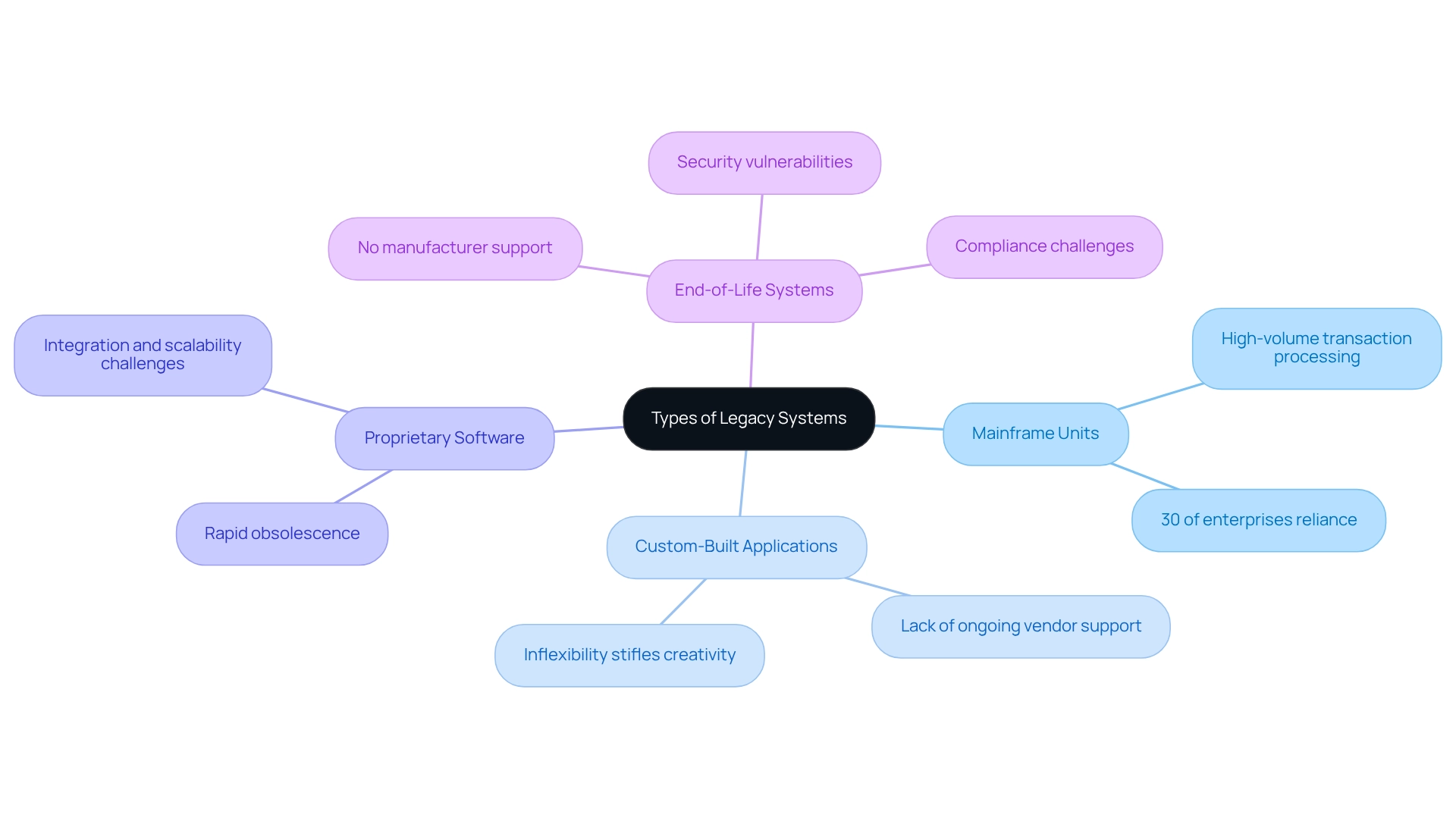
10 Notable Examples of Legacy Systems in Various Industries
A significant number of banks continue to rely on COBOL for their core banking operations, with estimates indicating that around 70% of banking transactions are still processed using this aging language. This dependence can significantly hinder innovation, as the complexity of updating these frameworks is exacerbated by inconsistent programming styles and a lack of documentation. To effectively tackle these challenges, a comprehensive evaluation of existing frameworks is essential, pinpointing areas that would benefit most from modernization.
Organizations should begin by gathering input from key stakeholders to ensure that requirements are accurately captured. By leveraging Avato’s Hybrid Integration Platform, businesses can develop a comprehensive strategy that aligns with their objectives and the evolving needs of their customers. This plan should encompass:
- Modeling new business processes
- Activity flows to chart a path to success
- Strategies for future-proofing frameworks to integrate new tools with existing assets
Notable migrations away from COBOL have been undertaken by organizations such as the UK Department for Work and Pensions and the New York Times, demonstrating that while challenging, modernization is achievable. Avato guarantees round-the-clock availability for essential connections, underscoring the importance of reliable connection solutions in addressing these legacy systems. Gustavo Estrada remarked, “Avato has the capability to streamline intricate projects and deliver outcomes within specified time limits and financial restrictions,” emphasizing the efficiency of contemporary unification solutions in overcoming these challenges.
Furthermore, involving stakeholders through workshops or feedback sessions can ensure that the integration strategy is refined for long-term resilience.
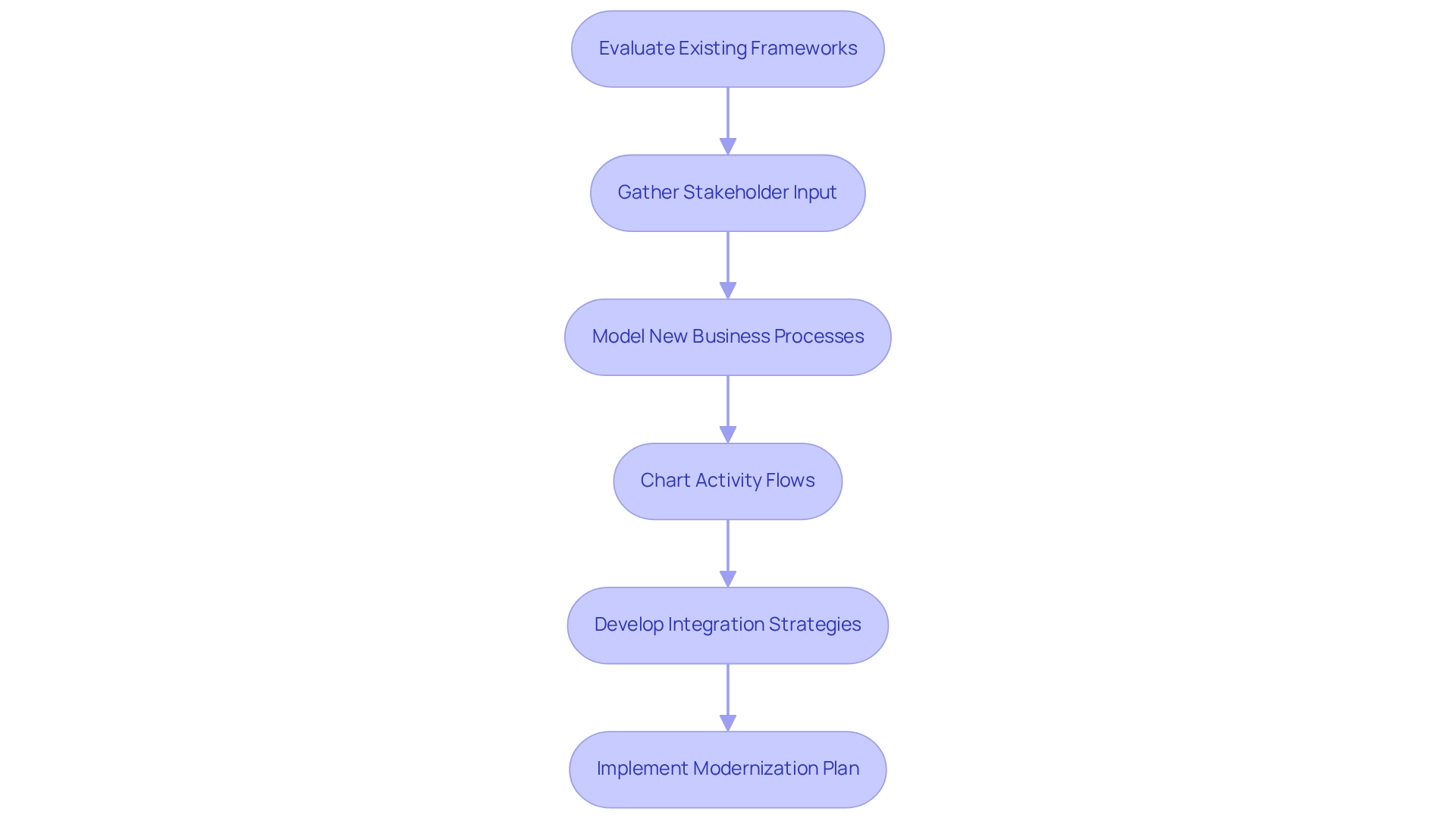
Why Organizations Still Rely on Legacy Systems
Organizations often continue to rely on legacy systems due to a combination of factors that create significant barriers to modernization.
-
High Replacement Costs: Transitioning to new systems can be prohibitively expensive, with estimates indicating that the costs associated with replacing legacy systems can reach millions of dollars. This financial burden frequently causes organizations to postpone essential upgrades, choosing instead to keep current infrastructures despite their limitations.
-
Familiarity: Employees are accustomed to current processes, fostering a culture of resistance to change. A study showed that almost 70% of employees demonstrate hesitation to embrace new technologies, primarily due to their comfort and familiarity with older setups. This resistance can hinder the implementation of modern solutions, even when they promise improved efficiency.
-
Integration Challenges: New systems may not easily integrate with existing processes, creating a complex web of compatibility issues. Organizations frequently encounter substantial unification challenges, resulting in heightened downtime and operational disruptions during the transition period. Avato’s dedicated hybrid integration platform is specifically designed to address these challenges, particularly in sectors like banking and healthcare, ensuring a smoother transition and enhancing business value by unlocking isolated assets.
-
Critical Operations: Legacy technologies frequently support mission-critical functions, making them challenging to replace without jeopardizing operational continuity. In fields such as banking and healthcare, where legacy systems exemplify the importance of data integrity and operational reliability, the stakes are especially high. Organizations must weigh the risks of disruption against the potential benefits of modernization.
-
Cost Implications of Maintaining Outdated Technologies: The ongoing upkeep expenses of outdated technologies can be unsustainable. A recent analysis suggested that companies using obsolete technologies could face expenses that are 2.4 times greater than those investing in modernization initiatives. Furthermore, companies successfully executing major modernization initiatives achieved performance improvements, including 5-7 percentage point increases in revenue growth rates. This statistic underscores the importance of framing modernization as a strategic investment linked to broader business goals.
-
Examples of Resistance to Change: Numerous case studies demonstrate the difficulties organizations encounter when trying to shift from outdated frameworks. For example, a healthcare provider struggled with employee pushback during a planned upgrade, ultimately delaying the project and incurring additional costs. As Gustavo Estrada noted, “Avato has the ability to simplify complex projects and deliver results within desired time frames and budget constraints,” highlighting the potential benefits of modernization through Avato’s platform.
In summary, although the dependence on older technologies is frequently based on practical issues, the long-term effects of sustaining these obsolete tools can obstruct organizational growth and innovation. Avato’s hybrid integration platform enables companies to prepare their operations for the future through smooth data and network integration, enhancing B2B customer experiences and closing the divide between traditional frameworks and contemporary expectations. Avato, which means “of dedication” in Hungarian, stands firmly behind its mission to architect the technology foundation required to power rich, connected customer experiences.

Modernization Strategies: Moving Beyond Legacy Systems
Effective modernization strategies for legacy systems encompass several key approaches:
- Phased Migration: This strategy involves gradually replacing legacy systems, allowing organizations to minimize disruption and manage risks effectively. By implementing changes in stages, businesses can ensure continuity of operations while adapting to new technologies. Statistics indicate that entities utilizing phased migration strategies have experienced success rates rise considerably, with many reporting smoother transitions and decreased downtime. Automation accelerates modernization efforts by streamlining testing, deployment, and maintenance processes, further enhancing the effectiveness of this approach.
- Cloud Migration: Transitioning applications to the cloud enhances scalability and flexibility, enabling businesses to respond swiftly to changing demands. As cloud technologies evolve, they offer opportunities for improved resource management and cost efficiency. Current trends indicate that cloud migration is emerging as a favored option for organizations aiming to modernize their outdated infrastructures, which are often considered legacy systems examples, with many experiencing improved performance and lower operational expenses. Customized application modernization roadmaps, such as those provided by Avato, can help businesses align their cloud migration efforts with growth goals.
- API Integration: Utilizing APIs to link legacy infrastructures with contemporary applications promotes interoperability and simplifies processes. This approach allows businesses to unlock the potential of their existing systems, which are legacy systems examples, while integrating new functionalities. Successful case studies demonstrate that organizations utilizing API integration have achieved significant improvements in operational efficiency and data accessibility, particularly when supported by Avato’s expert integration services.
- Re-engineering: Redesigning legacy applications to align with current business needs while retaining core functionalities is crucial for modernization. This approach not only improves performance but also guarantees that structures remain pertinent in a quickly changing technological environment. Companies that have adopted re-engineering practices, such as those involving legacy systems examples, report increased agility and better alignment with business objectives. The integration of advanced observability tools, as highlighted in the Observability and AIOps case study, can further support these efforts by enhancing predictive performance monitoring and automating cloud reliability.
Incorporating these strategies can lead to substantial benefits, including reduced costs, improved system performance, and enhanced user experiences. As John Hagel, Co-chairman of the Center for the Edge at Deloitte, aptly noted, “The longer a business waits, the more marginalized it will become.” This underscores the urgency for organizations to embrace effective modernization strategies to stay competitive in their respective industries.
Avato’s dependable, future-ready technology stack, encompassing services such as enterprise architecture, project management, and technical analysis, along with their dedicated hybrid connection platform, are crucial for businesses aiming to adjust to evolving demands and guarantee successful modernization efforts. Moreover, Avato’s collaborations with managed service providers improve their capacity to provide comprehensive solutions, establishing them as a reliable partner in traditional integration.

Integrating Legacy Systems with Modern Technologies
Integrating legacy systems with modern technologies can be effectively achieved through several key strategies:
- Middleware Solutions: Middleware serves as a crucial bridge, facilitating seamless communication between legacy and modern systems. By utilizing middleware, organizations can access a wider pool of developers proficient in modern programming languages, thereby decreasing dependence on specialized outdated knowledge. This approach not only enhances integration efficiency but also accelerates the modernization process. In fact, middleware enables companies to utilize a broader group of developers, which is crucial for decreasing the need for specialized outdated technology expertise.
- Data Transformation Layers: Implementing data transformation layers is essential for ensuring compatibility between different platforms. These layers transform data formats, allowing older platforms to engage with contemporary applications without significant rewrites. This method is particularly beneficial in regulated environments, where data integrity and compliance are paramount. Utilizing XML technologies within these layers guarantees that data stays interoperable and functional across different platforms, thereby improving the durability of the integrated frameworks. XML and schemas play a vital role in maintaining data integrity by validating data structures and ensuring compliance with industry standards.
- Service-Oriented Architecture (SOA): Embracing SOA principles enables entities to modularize their outdated frameworks, making updates and integrations more manageable. By breaking down monolithic applications into smaller, interoperable services, businesses can enhance flexibility and responsiveness to changing market demands. Current trends suggest an increasing acceptance of SOA in 2025, as companies aim to future-proof their technology stacks.
These approaches not only tackle the difficulties of merging outdated technologies but also correspond with the newest progress in middleware solutions. For example, Avato’s hybrid unification platform illustrates how organizations can streamline complex connection projects while preserving operational efficiency. The platform enhances the worth of outdated infrastructures by employing XML for data depiction and schemas for guaranteeing data reliability, which are essential for efficient integration.
Moreover, it offers real-time monitoring and alerts on performance, further improving operational oversight. Clients such as Gustavo Estrada from BC Provincial Health Services Authority have remarked, “Avato possesses the capability to streamline intricate projects and produce outcomes within specified timelines and financial limits,” emphasizing its efficiency in updating outdated infrastructures. As the landscape of technology continues to evolve, adopting these integration strategies will be essential for entities aiming to remain competitive.
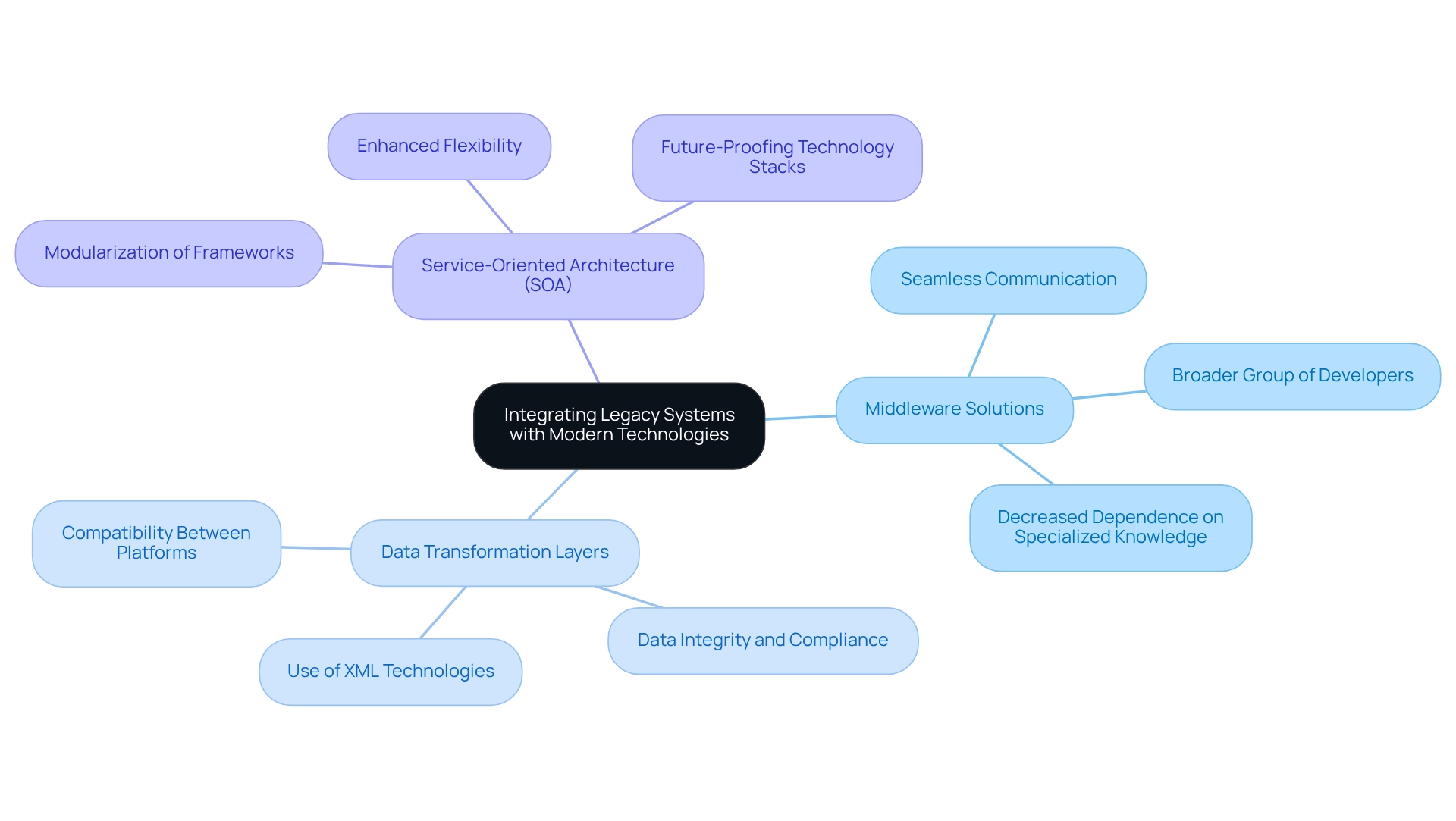
Benefits of Modernizing Legacy Systems
Updating outdated technologies provides numerous benefits that can significantly enhance operational efficiency for companies. Key benefits include:
- Improved Efficiency: Streamlined processes resulting from modernization lead to faster operations and reduced costs. Organizations that have undertaken modernization initiatives report a notable decrease in operational bottlenecks, allowing for smoother workflows and quicker turnaround times. For instance, companies that have migrated legacy systems to the cloud via rehosting have reported decreased hardware maintenance expenses and enhanced availability, optimizing resource allocation. Avato’s hybrid integration platform accelerates this process, ensuring that organizations can achieve these efficiencies without compromising on quality.
- Enhanced Security: Contemporary setups are equipped with advanced security features that mitigate vulnerabilities to cyber threats. As cyberattacks become increasingly sophisticated, upgrading legacy systems is crucial for safeguarding sensitive data and maintaining compliance with regulatory standards. Avato’s architecture is designed for secure transactions, making it a trusted partner for banks, healthcare, and government sectors.
- Increased Agility: By modernizing their infrastructure, organizations can respond more swiftly to market changes and evolving customer demands. This agility is essential in today’s fast-paced business environment, where the ability to pivot quickly can determine competitive advantage. Avato’s commitment to ensuring 24/7 uptime for critical integrations further emphasizes the reliability aspect of modernization.
- Better User Experience: Modern interfaces not only improve usability but also enhance employee satisfaction and productivity. A user-friendly system encourages greater adoption among staff, leading to more efficient task completion and a more engaged workforce. As noted by Tony Leblanc from the Provincial Health Services Authority, “Good team. Good people to work with. Extremely professional. Extremely knowledgeable.” This highlights Avato’s commitment to delivering results within desired time frames and budget constraints.
The impact of modernization on operational efficiency is underscored by data suggesting that entities experience a notable increase in productivity after modernization. Insights from industry leaders reinforce these benefits. Numerous entities have shared success narratives showcasing enhanced efficiency and cost reductions attained through modernization.
For instance, a recent case study demonstrated that a financial organization that upgraded its outdated technologies experienced a 30% improvement in operational efficiency within the first year, with generative AI significantly contributing to enhancing customer experience and operational effectiveness.
As we advance through 2025, the advantages of updating outdated infrastructures continue to grow, with entities progressively acknowledging the importance of a dependable, future-ready technology stack. Moreover, various types of modernization journeys—such as datacenter transformation, DevSecOps transformation, and modernizing application architecture—provide a comprehensive view of the modernization process and its various facets. This adaptability not only meets current demands but also positions businesses to thrive amid future challenges, particularly as generative AI becomes a key player in enhancing customer experience and operational efficiency in financial services.
Avato supports 12 levels of interface maturity, allowing organizations to balance speed of integration with the sophistication required to future-proof their technology stack.
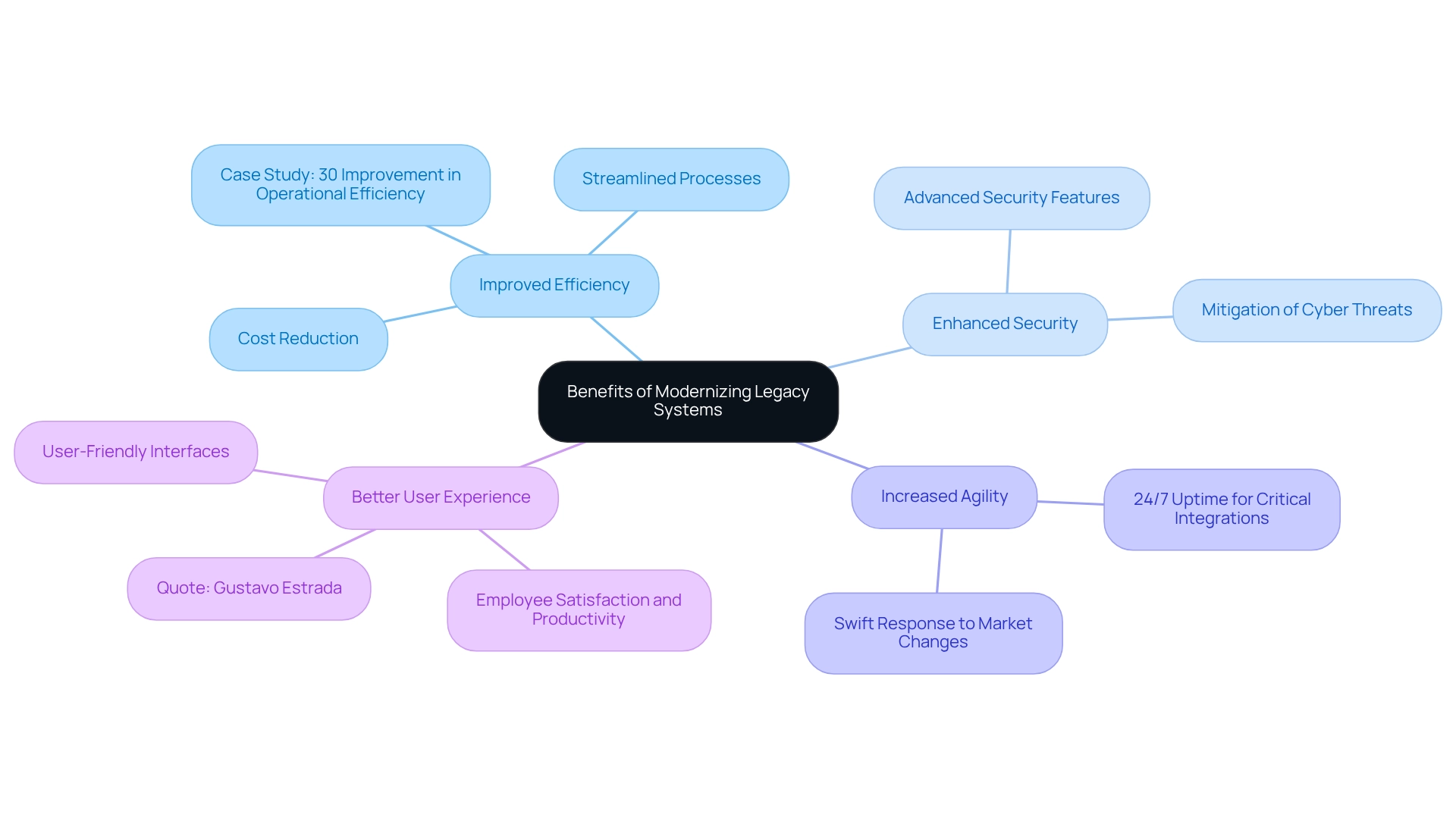
Case Studies: Successful Legacy System Modernization
- Bank of America: In a significant move towards modernization, Bank of America successfully transitioned its core banking frameworks to a cloud-based infrastructure. This strategic migration not only improved operational efficiency but also led to substantial cost reductions. By implementing Agentic AI, the bank automated complex, routine operations, enhancing decision-making capabilities and minimizing human error. Agentic AI managed routine and complex tasks more efficiently than traditional methods, significantly speeding up operations and reducing costs. The results were impressive, showcasing a marked increase in operational efficiency and a streamlined approach to handling both routine and complex tasks.
- U.S. Department of Veterans Affairs: The U.S. Department of Veterans Affairs implemented a vital enhancement of its VistA electronic health record platform. This modernization effort aimed to enhance interoperability and improve patient care across the healthcare system. By focusing on integrating risk and compliance into their transformation initiatives, the VA has positioned itself to sustain cost reductions while delivering better healthcare outcomes.
- Avato’s Role in Transformation: Avato plays a crucial role in simplifying complex connections for organizations like Bank of America and the U.S. Department of Veterans Affairs. With an emphasis on customer-focused solutions and proficient collaboration partners, Avato accelerates digital transformation through its hybrid connection platform. This platform is architected for secure transactions, making it a trusted choice for sectors requiring 24/7 uptime, such as banking and healthcare. Avato provides an extensive array of services, including enterprise architecture, project management, software development, and quality assurance, which are essential for tackling the challenges of integrating legacy systems. By leveraging Avato’s expertise, organizations can effectively revamp their outdated infrastructures, ensuring a connected foundation that supports contemporary operational demands. As Kirk Wolter from NORC and the University of Chicago noted, the implications of modernization efforts extend beyond immediate operational improvements, influencing long-term strategic decisions and sustainability across various sectors.
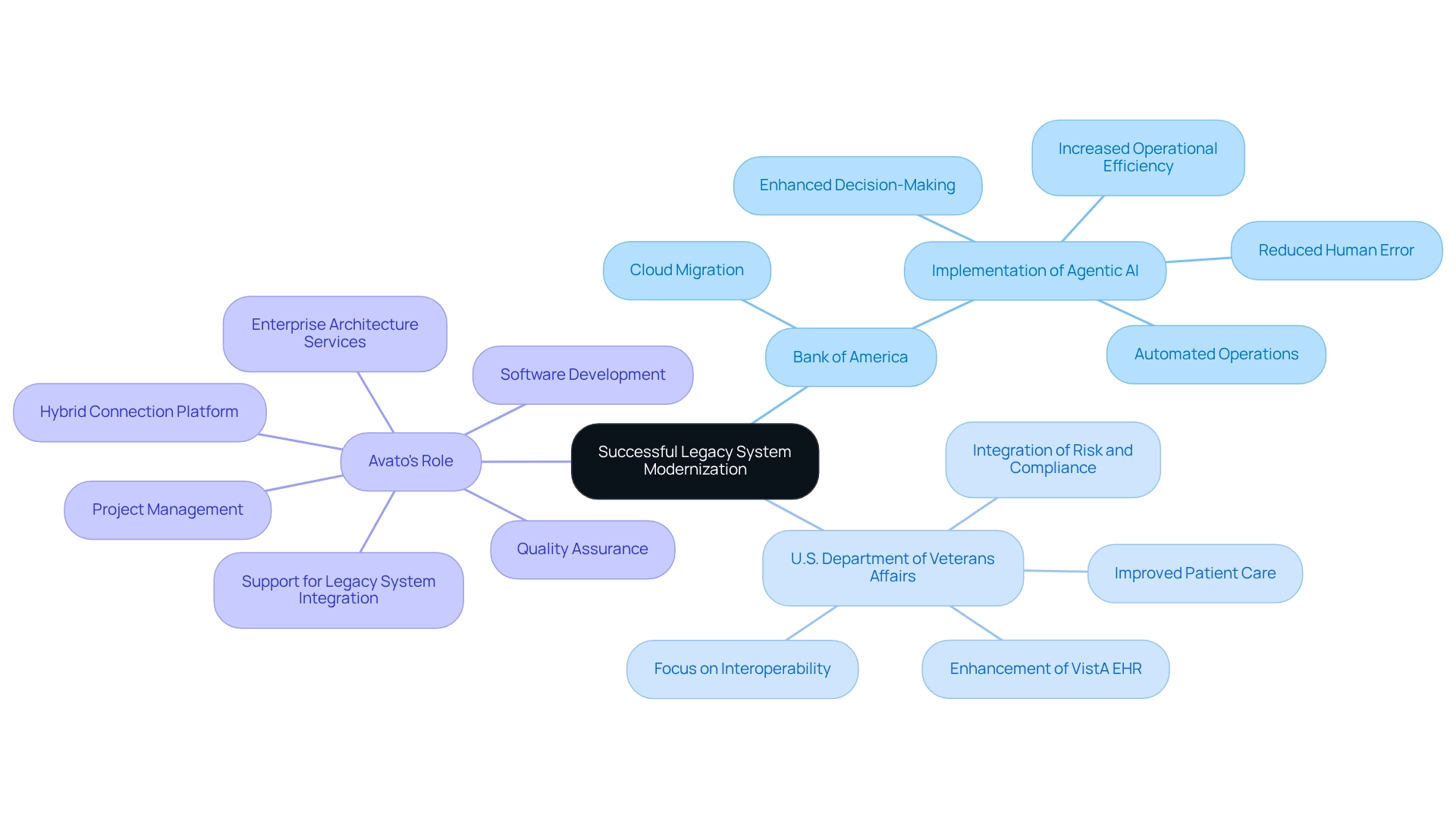
Key Takeaways: Navigating the Legacy System Landscape
Navigating the existing framework environment demands a profound understanding of the meanings, categories, and challenges inherent to these structures. In 2025, the urgency of modernization is undeniable, especially in competitive sectors like banking and healthcare, where agility and efficiency reign supreme. Organizations that fail to evolve risk falling behind; legacy systems can severely hinder innovation and adaptability to market demands.
Effective modernization strategies often draw on real-world case studies showcasing successful transitions from outdated frameworks to contemporary solutions. For example, advancements in AI-powered solutions are automating data migration processes, significantly minimizing errors and boosting efficiency. Additionally, cloud-based platforms are emerging as cost-effective and scalable avenues for modernization, enabling organizations to swiftly adjust to shifting demands.
Statistics reveal that many businesses face substantial obstacles in updating outdated technologies, with a significant percentage reporting issues related to the complexities of merging systems and data silos. Grasping these challenges is vital for crafting effective strategies. Key takeaways for navigating legacy systems include:
- Prioritize a robust integration platform, such as Avato’s hybrid integration platform, ensuring 24/7 uptime for critical operations.
- Leverage automation tools to streamline data migration and minimize manual errors, enhancing overall efficiency.
- Foster organizational alignment to ensure all stakeholders support modernization initiatives, a process in which Avato excels by mobilizing stakeholders and modeling new business processes.
Avato’s commitment to designing technology solutions is grounded in its history of integrating diverse frameworks and data, reflecting a dedication to simplifying complex integration challenges. Experts assert that a well-defined modernization strategy is essential for maintaining a competitive edge. As noted by Muzammil K., Marketing Manager, “A longer lifespan for the majority of heritage ecosystems existed before modernization. As a result, they would have a ton of information from company transactions.” This underscores the wealth of transactional data that can be leveraged for strategic advantage. By embracing modernization, organizations can unlock the full potential of their legacy systems while positioning themselves for future growth and innovation.
Furthermore, organizations can benefit from ongoing support and resources, such as the free webinar scheduled for January 29th at 12 PM EST. This session aims to assist attendees in addressing challenges related to cost reduction, efficiency improvement, protection against cyber threats, and fostering organizational alignment for modernization initiatives.
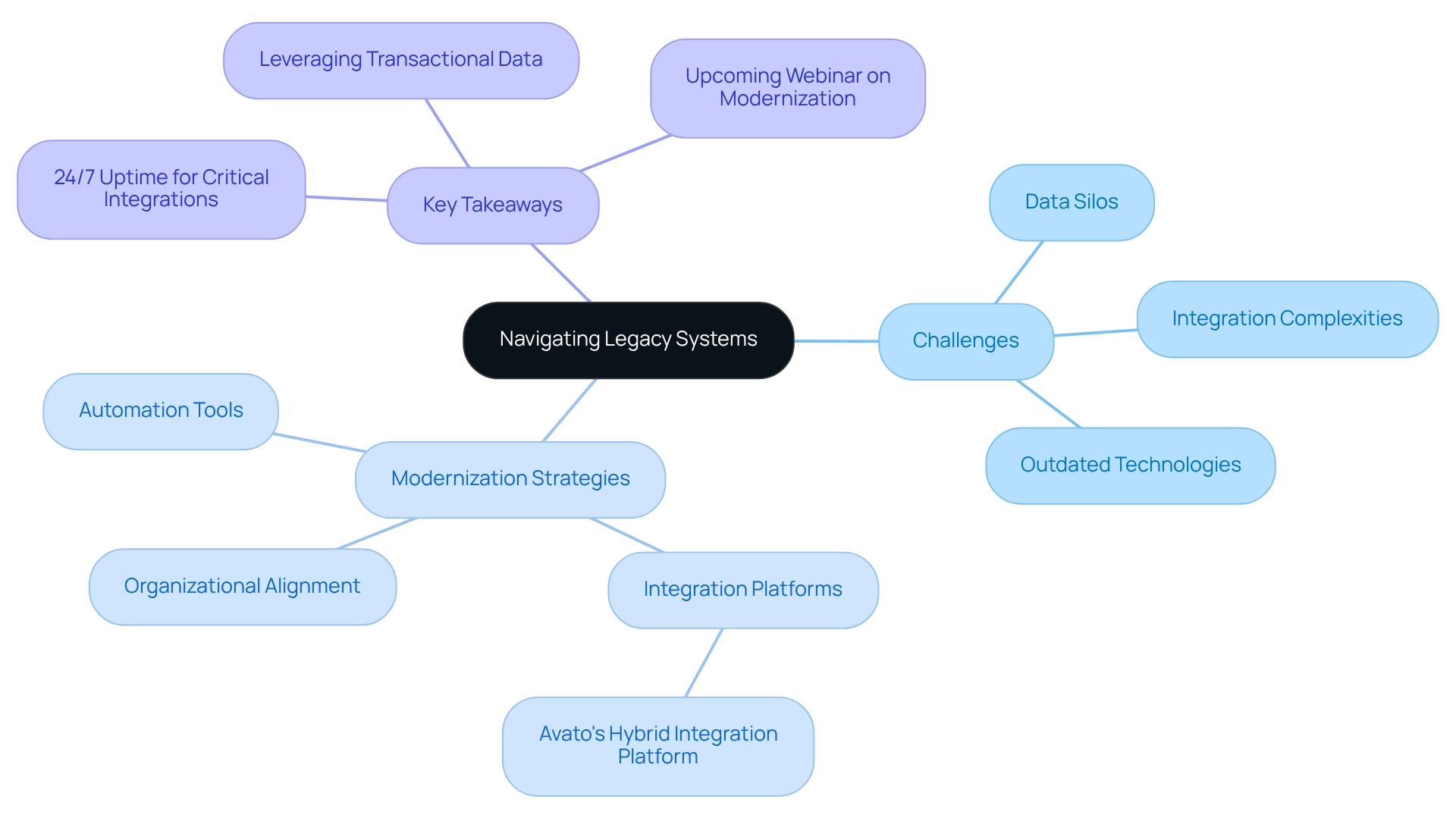
Conclusion
Legacy systems, despite their long-standing presence in organizations, pose a significant barrier to innovation and efficiency in today’s rapidly evolving technological landscape. Understanding the characteristics and types of these systems is crucial for organizations aiming to navigate the complexities of modernization. The challenges associated with legacy systems—ranging from high maintenance costs to integration difficulties—underscore the necessity for strategic investment in modernization initiatives.
Effective strategies for modernizing legacy systems, such as phased migration, cloud adoption, and API integration, can significantly enhance operational efficiency and security. Successful case studies, including those from Bank of America and the U.S. Department of Veterans Affairs, illustrate the transformative potential of embracing modern technologies. Organizations that prioritize modernization not only improve their resilience but also position themselves to respond swiftly to changing market demands.
Ultimately, the journey toward modernization is not merely a technical upgrade; it is a strategic imperative that can unlock new opportunities for growth and innovation. By leveraging advanced integration platforms like Avato’s, businesses can bridge the gap between legacy systems and modern expectations, ensuring a seamless transition that enhances both operational performance and user experience. Embracing this transition will empower organizations to thrive in an increasingly competitive digital landscape, paving the way for a future defined by agility, efficiency, and sustained success.

